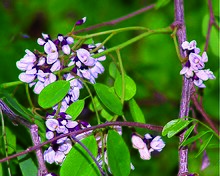| Dalbergia lanceolaria | |
|---|---|

| |
| Conservation status | |
 Least Concern (IUCN 3.1) | |
| Scientific classification | |
| Kingdom: | Plantae |
| Clade: | Tracheophytes |
| Clade: | Angiosperms |
| Clade: | Eudicots |
| Clade: | Rosids |
| Order: | Fabales |
| Family: | Fabaceae |
| Subfamily: | Faboideae |
| Genus: | Dalbergia |
| Species: | D. lanceolaria |
| Binomial name | |
| Dalbergia lanceolaria L.f. | |
| Synonyms | |
Dalbergia lanceolaria is a species of tree in the subfamily Faboideae and tribe Dalbergieae. It is a medium-sized tree growing to 20m tall and is native to: India, Sri Lanka, Nepal, Burma and Indo-China.
The bark of the tree is traditionally used as an analgesic and anti-diarrhoeal. The apiose isoflavone compound lanceolarin is found in its root bark.
Because it produces new stems (ramets), it is recommended for reforestation projects on degraded land where seeds are unlikely to grow successfully.
Subspecies
Plants of the World Online includes:
- D. lanceolaria var. errans (Craib) Niyomdham - Indo-China
- synonym: D. errans Craib
- D. lanceolaria var. lakhonensis (Gagnep.) Niyomdham & P.H.Hô - Indo-China
- synonyms: D. lakhonensis Gagnep, D. lanceolaria var. maymyensis (Craib) Thoth, D. maymyensis Craib
- D. lanceolaria subsp. paniculata (Roxb.) Thoth. - Indian Subcontinent to Indo-China
- synonyms include: Amerimnon paniculatum (Roxb.) Kuntze, D. hemsleyi Prain, D. paniculata Roxb.
Gallery
References
- Barstow, M. (2022). "Dalbergia lanceolaria". IUCN Red List of Threatened Species. 2022: e.T150284719A152201877. Retrieved 23 January 2023.
- Roskov Y.; Kunze T.; Orrell T.; Abucay L.; Paglinawan L.; Culham A.; Bailly N.; Kirk P.; Bourgoin T.; Baillargeon G.; Decock W.; De Wever A. (2014). Didžiulis V. (ed.). "Species 2000 & ITIS Catalogue of Life: 2014 Annual Checklist". Species 2000: Reading, UK. Retrieved 26 May 2014.
- ^ Phạm Hoàng Hộ (1999) Cây Cỏ Việt Nam: an Illustrated Flora of Vietnam vol. I publ. Nhà Xuẩt Bản Trẻ, HCMC, VN.
- ^ "Dalbergia lanceolaria", India Biodiversity Portal, retrieved 11 December 2015
- Kale, M.; Misar, A.V.; Dave, V.; Joshi, M.; Mujumdar, A.M. (2007), "Anti-inflammatory activity of Dalbergia lanceolaria bark ethanol extract in mice and rats", Journal of Ethnopharmacology, 112 (2): 300–304, doi:10.1016/j.jep.2007.03.024, PMID 17442513
- Rao, P.S.; Asheervadam, Y.; Khalilullah, M.; Murti, V.V.S. (1989), "A revised structure for the isoflavone lanceolarin", Phytochemistry, 28 (3): 957–958, doi:10.1016/0031-9422(89)80157-8
- Pandey, S.K.; Shukla, R.P. (2001), "Regeneration strategy and plant diversity status in degraded sal forests" (PDF), Current Science, 81 (1): 95–102
- "Plants of the World Online". Retrieved 16 October 2020.
External links
 Media related to Dalbergia lanceolaria at Wikimedia Commons
Media related to Dalbergia lanceolaria at Wikimedia Commons Data related to Dalbergia lanceolaria at Wikispecies
Data related to Dalbergia lanceolaria at Wikispecies
| Taxon identifiers | |
|---|---|
| Dalbergia lanceolaria |
|



